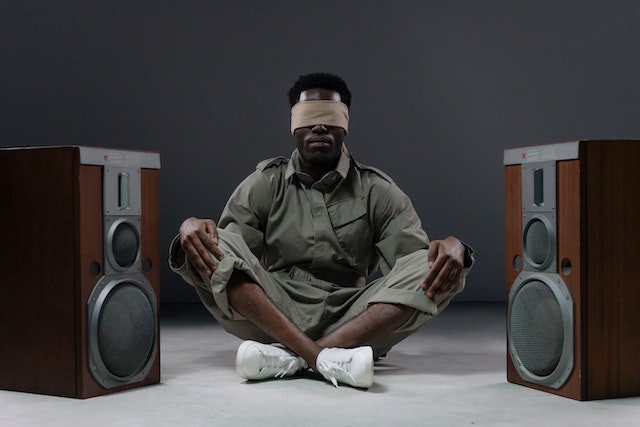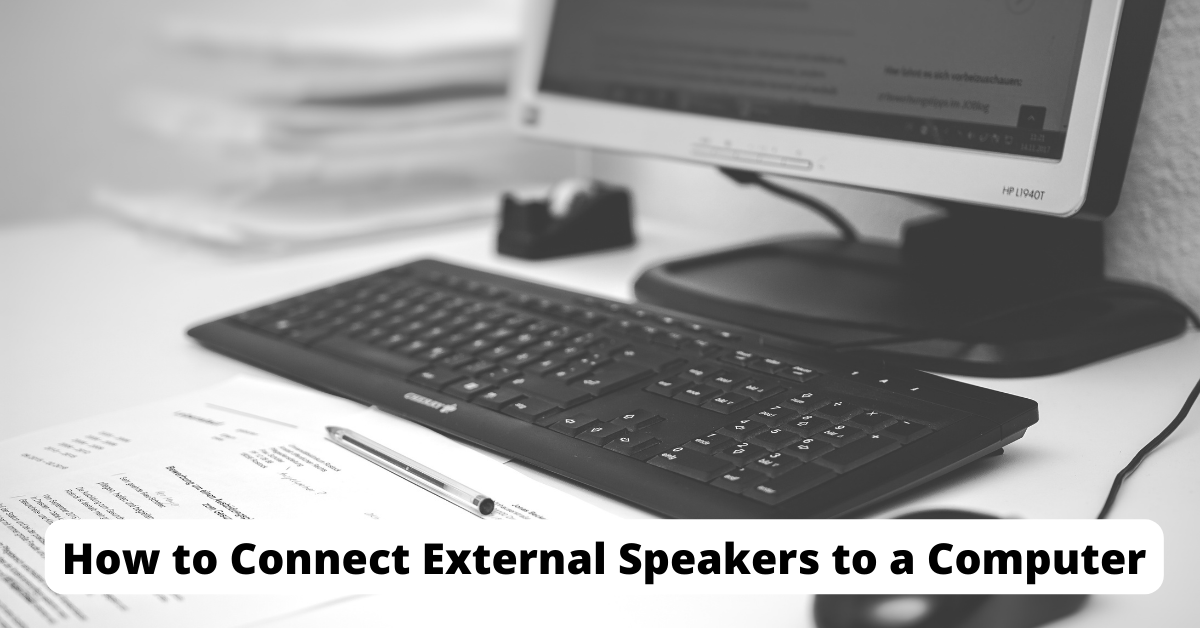Many people have a question: how to connect external speakers to a computer. This is important to know if you want to streamline your home entertainment. I was Wondering how to connect exterior lecturers to a laptop and what type of thread you should utilize. This blog will tell you how to connect external speakers to a computer and what cable you should use.
This blog is for beginners who’ve recently started using computers for their work. They usually find it hard to connect their external speakers or computer headsets. In this blog, I’ll share a step-by-step guide on connecting external speakers to your computer.
How to Connect External Speakers to a Computer?

You will need a cable compatible with both the speakers and the audio output to connect external speakers to a computer. The most common threads for this purpose are 3.5mm audio and USB cables. Here are the general steps to connect external speakers to a laptop:
- Please turn off the computer and unplug it from the power source.
- Connect one end of the audio cable to the audio output port on the computer. This is typically a 3.5mm jack located on the back or side of the computer.
- Connect the other end of the audio cable to the audio input port on the speakers. This is also typically a 3.5mm jack, but it may also be a USB port, depending on the speakers you are using.
- Plug in the speakers to a power source and turn them on.
- Turn on the computer and open the sound settings on your computer.
- Select the external speakers as the default audio output device.
- Adjust the volume on both the computer and the speakers to your desired level.
- Test the speakers by playing audio or a video on the computer.
Note: If your computer has a USB-C port, you can use USB-C to 3.5mm Audio Jack adapter to connect the external speaker.
We’ll discuss the various methods by which we can connect speakers to the PC and have the PC audio be made as sound by the speakers. Not just will we go over the “how-to” steps, but we’ll also have our understanding of the approach and instruments within the links.
A Primer On Computer Audio:

To understand how to improve the audio quality of your computer, it is essential first to know how computer audio works. Computers store digital playback audio, converted into numbers representing sound waves. The sound waves are converted into audio when you play them on your computer.
Analogue speakers require a constantly changing audio signal to function and produce sound.
A digital-to-analogue converter (DAC) must connect a speaker to a computer. The DAC will restore the computer’s digital audio into analogue audio that the orator can deliver as sound.
The connection methods described in this article involve a digital-to-analogue converter (DAC) at some point in the signal path.
The Various Connection Types Between Speakers & Computers
1- Bluetooth
2- USB/digital
3- Other wireless protocols
4- Internal audio interface
5- External audio interface
Choosing The Computer Audio Output:

Sometimes the computer is properly connected to its speakers, but the audio is not transmitting correctly.
When troubleshooting audio issues, the most common cause is that the computer’s audio output is not configured correctly.
The computer’s output audio must be assigned to the proper device to transmit audio from a computer to a speaker (or multiple speakers).
It’s important to mention that various speaker types can be connected to computers. I’ll reference this province as we drive ahead on attaching the different speaker types to computers.
Set the audio output on Windows OS, and follow this guidance:
- Control Panel > Sound > Playback
- Choose reasonable output, play an audio file, and turn up the sound volume of the output device.
Set the audio output on Mac OS, and follow this guidance:
- Strategy Preferences > Sound > Output
- Choice reasonable output, play an audio file and turn up the sound volume of the output apparatus.
Securing Speakers To Computers through Internal Audio Interfaces:

Some computer speakers come with USB connections. As their name suggests, these speakers connect to the computer via a USB port. By doing so, the sound quality is improved because it is digital rather than analogue.
To connect USB speakers to your computer, follow these simple instructions:
- Fill the USB cable into an open port on your pc.
- Connect the other end of the cable to the speaker.
- Turn on the speaker.
- Adjust the volume levels as desired.
The computer’s USB port powers USB speakers and have a digital-to-analogue converter. This allows the computer to output digital audio through the USB port, which is then converted to analogue and amplified by the speaker.
Plug-and-play USB speakers are great because you don’t have to install any drivers to use them. Many will work without a manual driver seat, making them super convenient.
The computer will typically automatically select USB speakers as its audio output device when a connection is made.
If you’re having trouble getting audio to play through your USB speakers, you can try changing your output device settings in System Preferences (Mac OS) or Control Panel (Windows OS).
For example, the Lightning cable is a digital hardwired connection with Apple iPhones. This type of connection is similar to a USB connection, as it connects the iPhone to a USB/digital speaker.
When shopping for USB-powered speakers, looking for models with built-in amplifiers is essential. Most computers do not output speaker-level signals, so an amplifier is necessary to boost the audio signal before it reaches the speakers.
Report On Drivers:
From this article, I’ll be recommending drivers.
It’s important to note that the term “driver” applies to two parts of the computer-speaker connection. Here’s what each word means:
“Driver”
subgroups – in this case, product name or type and needs level.
An orator driver transducer that converts electrical power into good locks. It is a vital element of any speaker system and is liable for reproducing the audio signal.
Pc hardware driver: A computer hardware driver is a set of digital files that allows a piece of PC hardware to convey with the computer’s functioning system.
I’ll refer to two things as “drivers” throughout this article to avoid confusion.
Speakers with a subwoofer:

If your speakers come with a subwoofer, the right speaker should be plugged into it. Ensure the subwoofer is turned on if it has a power switch on the back.
Laptop users:

To connect speakers to a laptop with no sound-out port, insert the mini plug into the headphones. It’s that simple!
Do I need to install drivers for speakers?
No – speakers do not need drivers. If no speakers appear to work with the computer, it may be that the sound card requires drivers to be installed.
Test the speakers:
After connecting your speakers, checking the volume to ensure it’s not too loud or quiet is essential. To test the speakers and ensure they’re working correctly, try opening a sound or video file, putting in an audio CD, or visiting a website like YouTube.
CONCLUSION:
If you have been looking for a solution to this problem, you’ve come to the right place! We’ve created this blog post to give tips and tricks for getting your external speakers up and running.
The first thing you’ll need to do is look at your computer’s sound settings. You can usually find them in the Control Panel, which you can get to by right-clicking on the orator hero in your Windows taskbar and selecting Sounds. Here, you’ll see a list of the various sound devices installed on your computer. Find the one that corresponds to your speakers and fix Properties. Thanks For Reading Our Article!
